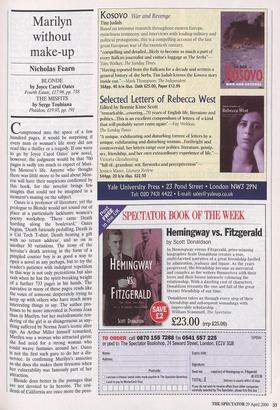Marilyn without make-up
Nicholas Fearn
Compressed into the space of a few hundred pages, it would be surprising if every man or woman's life story did not read like a thriller or a tragedy. If one were to go by Joyce Carol Oates' new novel, however, the judgment would be that 700 pages is sadly too much to expect of Mari- lyn Monroe's life. Anyone who thought there was little more to be said about Mon- roe will have their suspicions confirmed by this book, for the novelist brings few insights that could not be imagined in a moment's musing on the subject. Oates is a professor of literature, yet the prologue to Blonde would not sound out of place at a particularly lacklustre women's poetry workshop. 'There came Death hurtling along the boulevard,' Oates begins, 'Death furiously pedalling, Death in a Cal Tech T-shirt, Death bearing a gift with no return address', and so on in another 30 variations. The irony of the heroine's death arriving in the form of a pimpled courier boy is as good a way to Open a novel as any perhaps, but to try the reader's patience with indulgent repetition in this way is not only pretentious but also rash when he has the spirit-breaking weight of a further 733 pages in his hands. The narrative in many of these pages reads like the voice of someone desperately trying to keep up with others who have much more Interesting things to say. The author pro- fesses to be more interested in Norma Jean than in Marilyn, but her melodramatic ren- dering of the girl is as disingenuous as any- thing suffered by Norma Jean's iconic alter ego. As Arthur Miller himself remarked, Marilyn was a woman who attracted gurus; She had need for a strong woman who could weave fantasies around her. Oates Is not the first such guru to do her a dis- service. In confirming Marilyn's anxieties as she does she makes them tiresome when her vulnerability was famously part of her attraction.
Blonde does better in the passages that are not devoted to its heroine. The resi- dents of California are once more the peas- ants outside the walls of Hollywood's Camelot. This is a land where single moth- ers seem glamorous even when they are swigging from a gin bottle or knocking back fistfuls of aspirin dry. They seem dangerous too, and are well-represented in the form of Monroe's deranged mother, Gladys. The fraught relationship between mother and daughter is well drawn, with Norma Jean the former's beleaguered sounding-board. Gladys talks to her as though she were adult when they are alone together. She also accuses her of an adult's crimes accordingly, and the child is never sure whether she is her mother's salvation or burden. There are several other gasps of air, such as when Norma Jean's first hus- band shows dirty pictures of her to his envi- ous workmates, one of whom is a pre-matinees Robert Mitchum. Mitchum tears them up, asking 'What kind of SOB shows pictures like these of his wife?' These moments are too few, however, to rescue a novel in which Monroe gives the worst performance of her career.
Fortunately, if you have to buy one new book about Marilyn Monroe this week there is a more rewarding alternative in the form of Serge Toubiana's account of the making of The Misfits. The book includes 200 pictures taken by Magnum agency pho- tographers such as Eve Arnold and Henri Cartier-Bresson. In one, Marilyn's mascara is being applied as though the make-up artist is touching up a priceless fresco. In several she is dancing between Arthur Miller and John Huston as she does between Clark Gable and Montgomery Chit in the film. These photographs outscore Oates' novelisation on every count, including humour. A few pages after a heroic Gable with his stomach breathed in is a portrait of a tired, paunchy old coot looking like the sort of man who keeps fer- rets. The portrait is captioned by Miller's quote: 'He and Gary Langland are now one and the same person; I no longer know where one ends and the other begins.' The remark would be more apposite in the case of Monroe herself, who makes even the informal snapshots of this engrossing record look like movie stills. She is clearly best left to speak for herself in her favourite medium.



























































 Previous page
Previous page